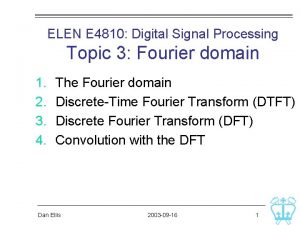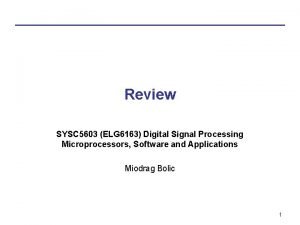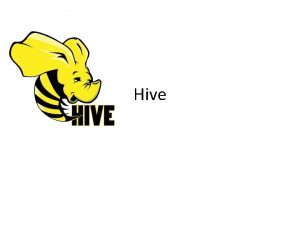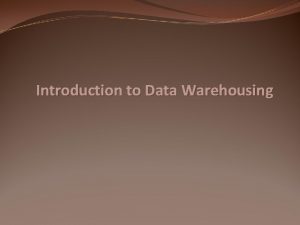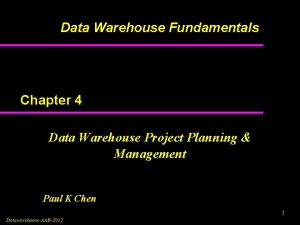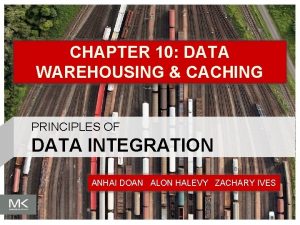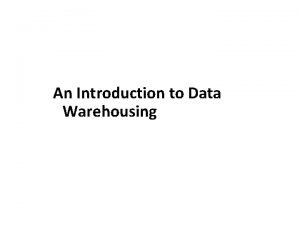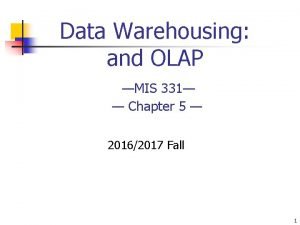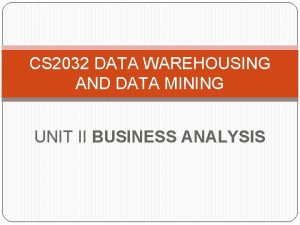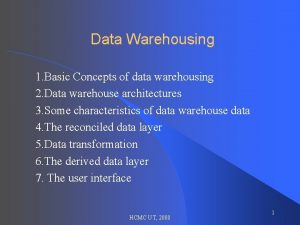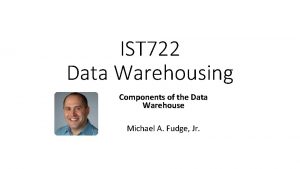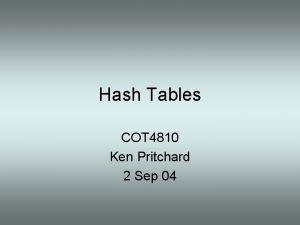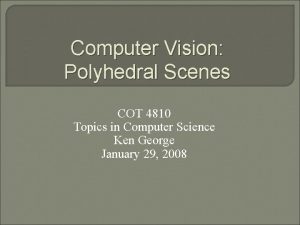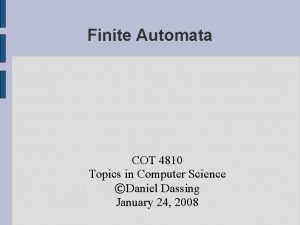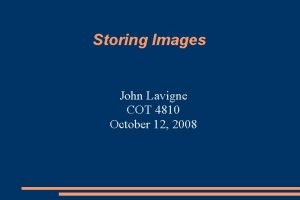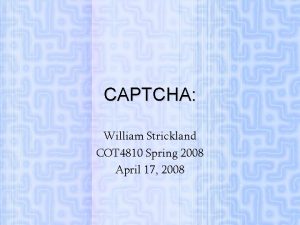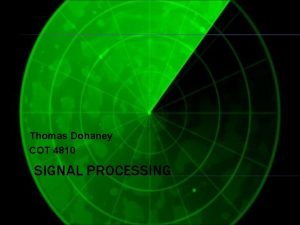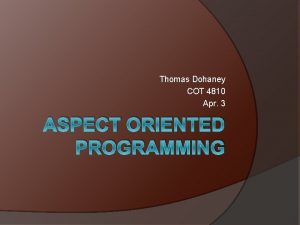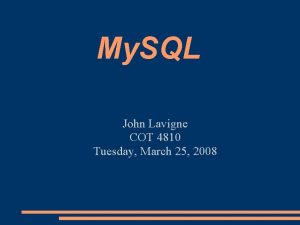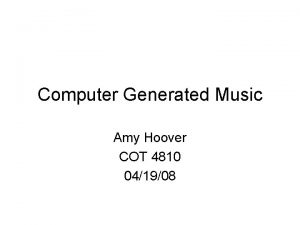Data Warehousing COT 4810 432008 Data Warehousing o





















- Slides: 21

Data Warehousing COT 4810 4/3/2008

Data Warehousing o Overview n n o Methods n n o Purpose History Design Tools Other aspects of DW

The Purpose of Data Warehousing o o Atomic data has a value now Sometimes the value needs to be realized through analytics n n Reporting Data mining

The Purpose of Data Warehousing o o o Warehouses enable Decision Support Turn static atomic data into valuable information Used to support a variety of other Business Intelligence (BI) platforms

The History of Data Warehousing o o Concept developed by IBM Researchers in 1980’s Really takes off in early-mid 1990 s n n 1991, Bill Inmon 1996, Ralph Kimball

What is a Data Warehouse? o Bill Inmon’s definition: “A data warehouse is a subject oriented, integrated, non-volatile, time variant collection of data [to support management decisions]. ”

What is a Data Warehouse? o Subject oriented n o Data is arranged by subject area instead of application Integrated n Data is collected and consistently stored from multiple sources

What is a Data Warehouse? o Non-volatile n Data is static o o It doesn’t matter when the question is asked Time variant n Allows for analysis of data over time

OLTP and OLAP o Online Transaction Processing (OLTP) o Online Analytical Processing (OLAP)

Differences OLTP OLAP Designed for real-time business operations Designed for analysis of business measures by category/attribute Processes a common set of transactions Optimized for bulk loads and large complex (sometimes unpredictable) queries Optimized to validate inserts/updates Assumes valid input (for the most part) Tuned for lots of concurrent users and connections Supports fewer users typically

OLTP and OLAP o They work well together… n OLAP supports offloaded OLTP data o n n No longer needs to accumulate in the application database (or on stored media) Less data, less index maintenance Allows OLTP to perform at peak transaction efficiency o Smaller OLTP database = better performance

What does it look like?

Data Marts o A Data Mart hosts a specific subset of data o Multiple Data Marts can compose what BI/DSS views as the Data Warehouse

Inside the Warehouse o Data is captured from source from via an ETL process 1. 2. 3. o Extract source data Transform source data Load into Warehouse Typically data is organized into Fact and Dimension tables

Fact Tables o Numerical data representing a specific activity n Details about the sale of a product o o o How many How much When What store Fact tables exist at the center of the Star Schema

Dimension Tables o Characteristics of the facts that offer a business perspective n Details about when a product was sold o o o Was it a weekday or weekend Was it a holiday First of the month, last of the month

Star Schema (ROLAP) http: //msdn 2. microsoft. com/en-us/library/aa 902672(SQL. 80). aspx

Cubes (MOLAP) o Takes multiple dimensions and optimizes a view http: //www. selectorweb. com/images/olap_cube. gif

Other Aspects of the Data Warehouse o o Data Mining User Interface design Requirements for Business Intelligence predictions or forecasts Data “Webhouse”

Questions? o o Why did Data Warehousing get a boost in the 1990 s? What are the steps in the ETL process?

References o o o Kimball, Ralph. The Data Warehouse Toolkit. Wiley Publishing. 2 nd Edition. April, 2002. Inmon, W. H. Building the Data Warehouse. Wiley Publishing. 4 th Edition. October, 2005. Dave Browning and J. Mundy. “Data Warehouse Design Considerations. ” Microsoft SQL Server Technical Articles. December, 2001.
 Elen 4810
Elen 4810 Elen 4810
Elen 4810 Sysc 4810
Sysc 4810 What is kdd process in data mining
What is kdd process in data mining Hive
Hive Crm data warehouse models
Crm data warehouse models Data warehouse and olap technology for data mining
Data warehouse and olap technology for data mining Oracle data warehouse best practices
Oracle data warehouse best practices Introduction to data mining and data warehousing
Introduction to data mining and data warehousing Operational and informational data store in data warehouse
Operational and informational data store in data warehouse Coffing data warehousing
Coffing data warehousing Data warehouse component
Data warehouse component Data warehousing project management
Data warehousing project management 1keydata data warehousing
1keydata data warehousing Data warehouse principles
Data warehouse principles An overview of data warehousing and olap technology
An overview of data warehousing and olap technology Introduction to data warehouse
Introduction to data warehouse An overview of data warehousing and olap technology
An overview of data warehousing and olap technology Concept hierarchy in data warehousing
Concept hierarchy in data warehousing Cognos impromptu in data warehousing
Cognos impromptu in data warehousing Data warehouse basic concepts
Data warehouse basic concepts Inmon cif
Inmon cif

